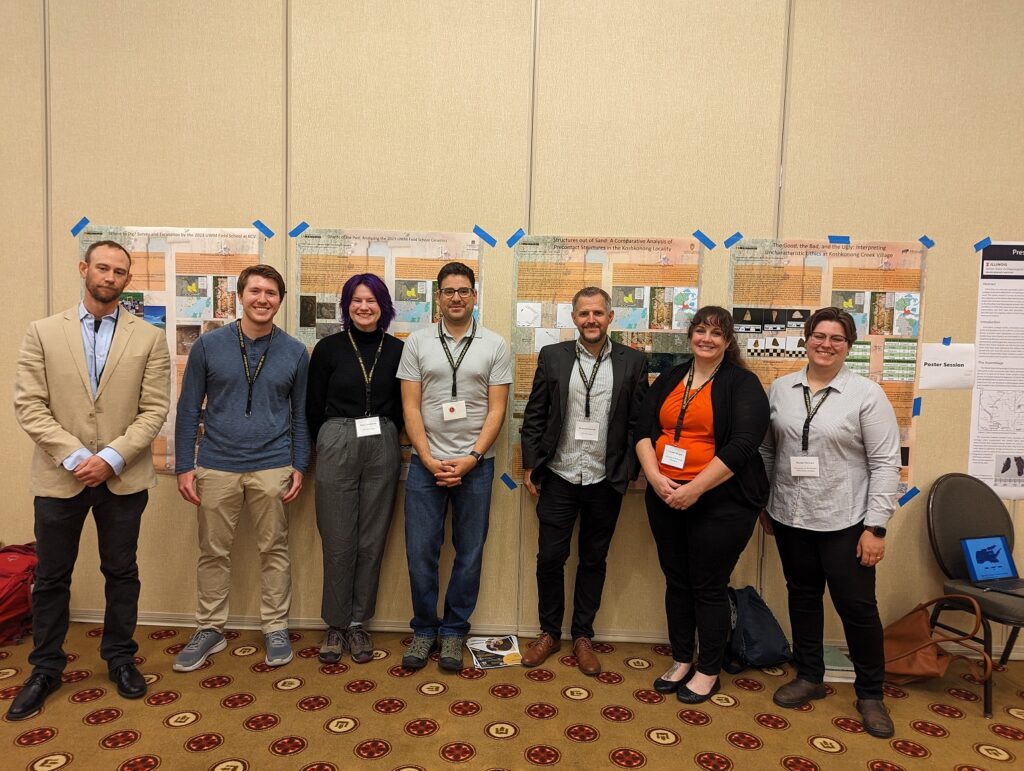By Pete Geraci

Left to Right: Sean Gleason, Ian Auger, Elsie Touchstone, Gil Amador, Dr. Richard Edwards, Crystal Morgan, Rachel Stewart
UWM Anthropology students and faculty attended the 66th Annual Midwest Archaeological Conference this month in Bowling Green, Kentucky. This year’s conference theme was Engaging With Communities, celebrating the efforts of Archaeologists to engage with a wide-range of communities.

Students working at KCV during the 2023 Archaeological Field School.
UWM was well-represented at this year’s conference by ten students and Dr. Richard Edwards who led a poster symposium highlighting the results of the 2023 UWM Archaeological Field School at Koshkonong Creek Village in Jefferson County, WI. Posters covered topics such as survey and excavation procedures, ceramic analysis, lithic analysis, and a comparative analysis of sites within the Koshkonong locality.

Crystal Morgan, Student Paper Award Winner.
Congratulations are also in order for ASU President and Graduate Student, Crystal Morgan. She won the The Midwest Archaeological Conference Student paper competition for her paper; Me, Myself, and Koshkonong: A Look at Intersite Specialization and Identity at the Oneota Koshkonong Locality through the Lens of Paleoethnobotany. The student paper competition was created to promote scholarly excellence among students conducting archaeological research in the Midwestern U.S. Awards are decided by the MAC Student Paper Committee, based on intellectual merit and methodological execution.
Student Participants:
Grad
Crystal Morgan
Sean Gleason
Undergrad
Gil Amador
Rachel Stewart
Elsie Touchstone
Ava Wolcott
Anissa Zaske (Spring 2023 grad)
Non-UWM-Undergrad
Ian Auger (UW-Madison)
Sydney Davis (Metcalf – recently graduated from Southern Utah University)
Catherine VanKammen (Marquette University)
Abstracts:
Session
The University of Wisconsin-Milwaukee Archaeological Field School returned to the Koshkonong Creek Village (KCV) in the summer of 2023. The students learned field survey and excavation techniques at KCV, a 12-15th century Oneota village in southeastern Wisconsin. The students excavated over 100 square meters and identified numerous artifacts, features, and structures. The posters in this session present the preliminary results of the analyses from the 2023 KCV excavations.
Ian Auger et al.
Structures Out of Sand: A Comparative Analysis of Precontact in the Koshkonong Locality The University of Wisconsin-Milwaukee Archeological Field School returned to the Koshkonong Creek Village (KCV) over the summer of 2023. KCV was occupied from the 12th to the 15th century in Southeastern Wisconsin, near the northwest shore of Lake Koshkonong. This poster will focus on the nature of the structures excavated at the 2023 Field School. These structures will be contextualized with other structures identified elsewhere at KCV and at the neighboring sites of Carcajou Point and Crescent Bay. We will be investigating architectural and organizational features of the structures to better understand the intra- and intervillage dynamics. [Poster Symposium – Excavating the Past: UWM Field School Excavations at the Koshkonong Creek Village, Saturday, 9:00am, Jimmy Feix Ballroom]
Rachel Stewart et al.
The Good, the Bad, and the Ugly: Interpreting Uncharacteristic Lithics at Koshkonong Creek Village (47JE0379) As an archaeological culture, the Oneota are known for their expediently made, “ugly”, stone tools. Previous research of the Oneota site Koshkonong Creek Village (KCV), located in south-central Wisconsin, has theorized that inhabitants, having access to limited resources, opted to spend their time and energy on other aspects of life rather than on creating elaborate stone tools. Excavations during the 2023 field school at KCV uncovered tool forms consistent with this energetic efficiency theory. Additionally, several well-made Madison points were recovered. While this energetic efficiency theory prevails, the presence of these uncharacteristic points in the archaeological record demonstrates that there were periods where time and energy were available for such endeavors. Using the 2019 Jeske et al. lithic schema, we analyzed a sample of lithic materials to demonstrate this difference in energy investment. This research further informs our understanding of the complex culture of the people who lived at KCV.
Elsie Touchstone
Sherds of the Past: Analyzing the 2023 UWM Field School Ceramics Koshkonong Creek Village (KCV) has played a pivotal role in our understanding of the Koshkonong Locality and has aided in the understanding of the Oneota archaeological culture more broadly. In 2023, the University of Wisconsin – Milwaukee (UWM) archaeological field schools continued its investigations at this site. KCV dates to AD 1050-1430 and is located in southeastern Wisconsin (Jeske et al. 2020). The focus of this poster is to compare the ceramic types and motifs recovered from the 2023 field school with previous analyses. In particular, we will be looking to assess if previous patterns hold in this new portion of the site, such as the ratio of Busseyville Grooved Paddle to smoothed vessels and the proportional representation of different rim forms (Carpiaux 2018; Schneider and Carpiaux 2020).
Student Paper Winner!
Crystal Morgan
Me, Myself, and Koshkonong: A Look at Intersite Specialization and Identity at the Oneota Koshkonong Locality through the Lens of Paleoethnobotany
The Koshkonong Locality, an Oneota cluster of archaeological sites in south central Wisconsin, has nine habitation sites located around the northwest side of Lake Koshkonong. While Oneota localities are made up of multiple sites where individuals share similar identities – as seen by their subsistence patterns, pottery, and lithics – this theory is also seen at the cluster and site levels. Paleoethnobotany provides a unique lens for understanding identity because it informs researchers about people’s diet, impact on environment, climate change, and social organization. This paper analyzes data collected by Dr. Richard Edwards for two sites at the Koshkonong Locality, Koshkonong Creek Village and Crescent Bay Hunt Club, by comparing intersite ubiquity and density statistics to determine if specialization is present at one or both locations based on plant remains alone. This study will add to the growing research of nested identities and interconnectedness of communities for ancient indigenous cultures.